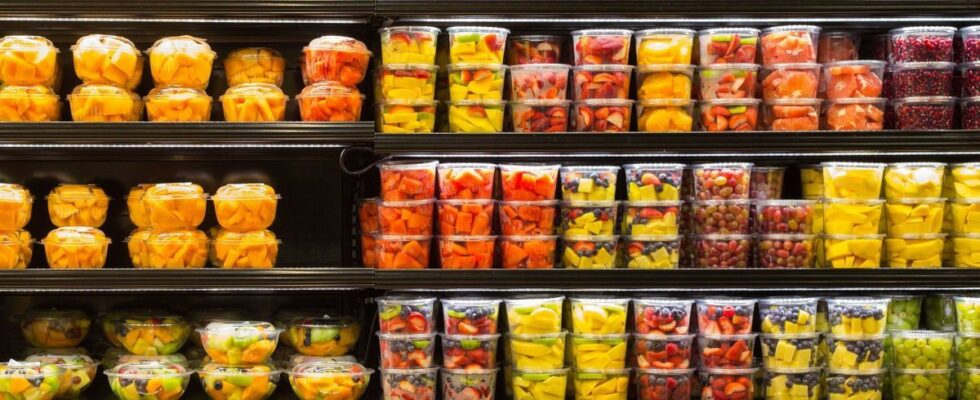Published on
updated on
Reading 3 min.
The ham, cooked in its plastic mold, is quickly placed in trays made of the same material: in the Monique Ranou factory of the distributor Intermarché, plastic is essential as in the entire food chain. But alternatives exist.
Frédéric Giffon, the director of the Mousquetaires/Intermarché factory in Finistère, takes off his hairnet as he leaves the production site. Packing the 125 tonnes of food that leave the factory every day in something other than a plastic tray? That would require changing the entire production line, he explained to AFP during a visit to the site in June 2024.
In mass consumption, “the product is inseparable from the packaging“, confirms Bertrand Swiderski, director of social and environmental responsibility at the giant Carrefour. To reduce the use of plastic, “There is an industrial bet to be made, with major investments at stake“.
The subject is important: the collective “Break Free From Plastic“estimates that 438 million tonnes of new plastics are manufactured each year in the world. The majority of greenhouse gas emissions linked to plastic (90%) come from its production, but the treatment of plastic waste alone generates as much as “two Belgiums”, according to the collective.
In a “plastic atlas”, published in 2020, the Heinrich Böll Foundation, close to the German party Alliance 90/The Greens, estimated that more than 10% of the plastic produced was used in “consumer goods”, and 36% in packaging, “mainly single-use”.
“Still slowly”
However, “There is less and less packaging on supermarket shelves“, assures AFP Franck Charton, the general delegate of Perifem, which brings together the players in distribution. “Whether it’s manufacturers, stores or consumers, everyone wants to move in this direction.”
Supermarkets are trying to reduce the use of single-use packaging in cut-to-size or unit sales: “To wrap your piece of beef or a portion of lasagna for example, we encourage the use of stainless steel containers.“, reusable, says Franck Charton.
Supermarkets can also reduce “industrial and commercial packaging“, those that customers do not necessarily see, the plastic film surrounding the pallets for example, he adds. Roadmaps have been established by the sector in France.
At the producer level, things are changing”still slowly, but very surely”assures AFP Ilec, the French representative of the agro-industry giants whose members include Coca-Cola, L’Oréal, Lactalis and Haribo. The sector has “5.5 million tonnes of household packaging put into circulation” in 2022 in France, a figure that has been slightly increasing for several years.
Disparities by country
Levers have been identified: elimination of non-essential packaging, larger formats, refills with flexible packaging. And of course bulk, even if there are still reservations and not all products can do without packaging.
The brake may also be linked to consumer habits, who are more or less ready to buy unpackaged foods depending on the country.
Carrefour also observes strong disparities in the treatment of plastic waste. Overall, more than half of the plastic used in the entire value chain goes to landfill, and only a quarter is recycled, its CSR director explains to AFP. The recycling rate is disparate. It is around 26% in France, it climbs to 47% in Spain but falls back to 1% in Brazil.
Bertrand Swiderski gives the example of fruits and vegetables as a vector of hope: plastic packaging began to be removed in 2016, and despite initial reluctance, “customers are getting used to it”.
Since January 2022, plastic packaging has even been banned in France for fruits and vegetables, even if environmental protection associations deplore too many exemptions, 29 in total. An extension at the European level could take place by 2030.
